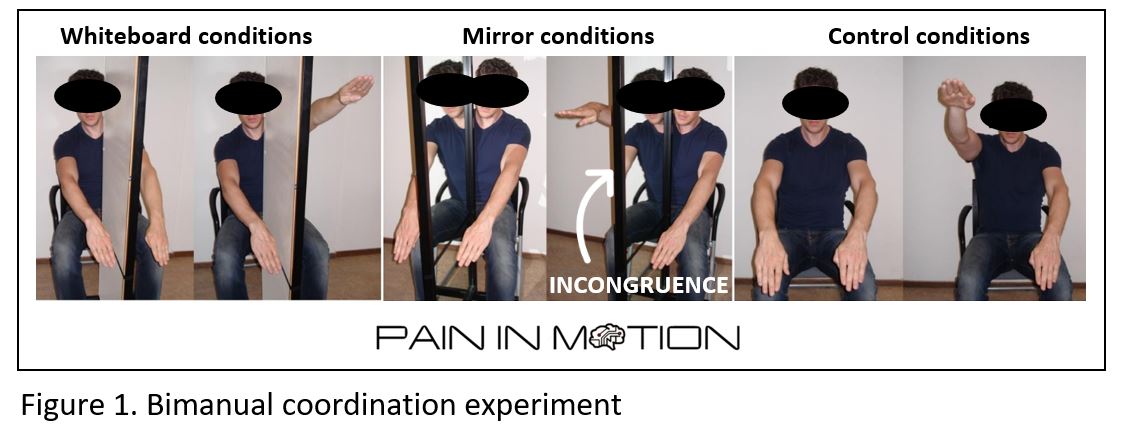Musculoskeletal pain is a highly prevalent disorder. People often seek help from a physiotherapist to relieve their pain and related limitations. Despite the high variety of treatment options, it remains quite a challenge to find the best treatment for a specific patient. This can be due to the fact that treatment effects for people with musculoskeletal pain are low to moderate at best and underlying mechanisms are not well understood. An interesting theory was developed which provides a possible explanation for unexplained chronic pain conditions like non-specific low back pain (Harris 1999).
It is proposed that, as a result of maladaptive neuroplasticity, sensorimotor incongruence could be a contributor to ongoing pain in people with musculoskeletal pain. Sensorimotor incongruence is best interpreted as a mismatch between the predicted sensory consequences of motor output and the actual proprioceptive and visual input. The concept is similar to motion sickness; when we feel nauseated or dizzy when for instance reading a book while riding the bus. The idea is that, like motion sickness, this mismatch within the sensorimotor system can generate pain in the long run, as a warning signal for incongruence.
The effect of sensorimotor incongruence has been tested in experimental settings by placing people in an environment which creates an artificial form of incongruence to see if participants experience (more) pain and other relevant symptoms such as discomfort, stiffness, tiredness and so on. A bimanual coordination experiment is often used to create such an artificial sensorimotor conflict via a mirror (figure 1 provides an example of this experiment). In the experimental conditions of the bimanual coordination experiment, participants perform arm movements in a congruent and incongruent manner while a mirror or whiteboard is placed between their limbs. Therefore, one limb is constantly hidden from vision. Importantly, a mismatch in sensorimotor information processing – causing incongruence! - is created when participants perform incongruent arm movements while looking in the mirror. Participants perform congruent and incongruent arm movement without visual manipulation in the control conditions.

Figure 1. Bimanual coordination experiment
As there were already a couple of experimental studies published looking at sensorimotor incongruence, we decided to conduct a systematic review on this topic to review the existing literature and to find out whether sensorimotor incongruence generates pain in people with musculoskeletal pain (Don et al. 2016).
Following the Preferred Reporting Items for Systematic Reviews and Meta-Analyses (PRISMA) guidelines, we conducted a systematic search in multiple databases until January 2015. Studies were included if they investigated sensorimotor incongruence in relation to pain and/or other sensory disturbances in people with musculoskeletal pain or healthy individuals. Eight studies were included. All studies used a bimanual coordination experiment to create artificial sensorimotor incongruence. Studies included dancers and musicians with- and without musculoskeletal complaints and people with different types of musculoskeletal pain (e.g. people with chronic- and acute whiplash-associated disorder and fibromyalgia) and/or healthy individuals.
Results show that pain and other sensory disturbances due to sensorimotor incongruence were frequently reported in people with musculoskeletal pain compared to control conditions (where participants performed arm movements without manipulation of visual feedback). However, there were no differences between congruent and incongruent conditions, making it highly unlikely that sensorimotor incongruence is (solely) responsible for this effect. Contrary to the people with musculoskeletal pain, reports of pain and sensory disturbances were either very low or did not occur at all in healthy individuals.
In summary, there is no evidence that experimental sensorimotor incongruence triggers pain in healthy individuals and in people with chronic musculoskeletal pain. However, people with chronic musculoskeletal pain report more sensory disturbances and pain during the experimental conditions. We believe this is an interesting finding since this indicates that people with musculoskeletal pain are more prone to experience pain and other sensory disturbances due to visual manipulation.
Have your say:
“Should physiotherapists use visual feedback more often as an additive in the treatment of people with non-specific musculoskeletal pain to enhance analgesic effects?”
Vote on: https://goo.gl/aIHhfL
Follow the results on: https://goo.gl/C2aOtM
Sanneke Don
Sanneke completed her physiotherapy degree and undertook a Master degree on Psychosomatic Physiotherapy. Currently, she’s conducting her PhD on sensorimotor incongruence and visual feedback at the Vrije Universiteit Brussel.
2017 Pain in Motion
References and further reading:
Harris AJ. Cortical origin of pathological pain. Lancet. 1999;354(9188):1464-1466.
https://www.ncbi.nlm.nih.gov/pubmed/10543687
Don S, Voogt L, Meeus M, De Kooning M, Nijs J. Sensorimotor Incongruence in People with Musculoskeletal Pain: A Systematic Review. Pain Practice. 2016 May 21.